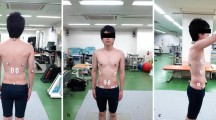Abstract
The aim of this study was to investigate the coordination between the innermost muscle layer of the ventro-lateral abdominal wall, the transversus abdominis (TrA), and other trunk muscles, in reaction to a load-release without the postural demand of keeping the trunk upright. Eleven healthy male volunteers participated. Intramuscular fine-wire electromyography (EMG) was obtained bilaterally from the TrA, rectus abdominis (RA), obliquus externus (OE) and erector spinae (ES) muscles. The subjects lay on their right side on a horizontal swivel-table with immobilized pelvis and lower limbs and with the trunk strapped to a movable platform allowing for trunk flexion and extension. Subjects maintained trunk flexion or extension at different force levels against a static resistance, which was suddenly released. They were instructed to resume the start position as fast as possible. EMG signals were analysed with respect to amplitude and timing of muscle activation. Following released static flexion, TrA increased its activity in synergy with ES. Also in released static extension, TrA increased its activity, but now in synergy with RA and OE. The direction-independent activation of TrA indicates a role of this muscle in controlling inter-segmental movements of the lumbar spine. This function was not accompanied by an early activation of TrA as has been shown previously for trunk perturbations in standing, i.e. a situation with an additional demand of maintaining the trunk posture upright against gravity.





Similar content being viewed by others
References
Aspden RM (1989) The spine as an arch. A new mathematical model. Spine 14:266–274
Barker PJ, Briggs CA, Bogeski G (2004) Tensile transmission across the lumbar fasciae in unembalmed cadavers: effects of tension to various muscular attachments. Spine 29:129–138
Barker PJ, Guggenheimer KT, Grkovic I, Briggs CA, Jones DC, Thomas CD, Hodges PW (2006) Effects of tensioning the lumbar fasciae on segmental stiffness during flexion and extension: Young Investigator Award winner. Spine 31:397–405
Cholewicki J, Reeves NP (2004) All abdominal muscles must be considered when evaluating the intra-abdominal pressure contribution to trunk extensor moment and spinal loading. J Biomech 37:953–954. Author reply 955–956
Cholewicki J, Panjabi MM, Khachatryan A (1997) Stabilizing function of trunk flexor-extensor muscles around a neutral spine posture. Spine 22:2207–2212
Cholewicki J, Juluru K, McGill SM (1999) Intra-abdominal pressure mechanism for stabilizing the lumbar spine. J Biomech 32:13–17
Cholewicki J, Greene HS, Polzhofer GK, Galloway MT, Shah RA, Radebold A (2002) Neuromuscular function in athletes following recovery from a recent acute low back injury. J Orthop Sports Phys Ther 32:568–575
Chow DH, Man JW, Holmes AD, Evans JH (2004) Postural and trunk muscle response to sudden release during stoop lifting tasks before and after fatigue of the trunk erector muscles. Ergonomics 47:607–624
Cresswell AG (1993) Responses of intra-abdominal pressure and abdominal muscle activity during dynamic trunk loading in man. Eur J Appl Physiol Occup Physiol 66:315–320
Cresswell AG, Thorstensson A (1994) Changes in intra-abdominal pressure, trunk muscle activation and force during isokinetic lifting and lowering. Eur J Appl Physiol Occup Physiol 68:315–321
Cresswell AG, Grundstrom H, Thorstensson A (1992) Observations on intra-abdominal pressure and patterns of abdominal intra-muscular activity in man. Acta Physiol Scand 144:409–418
Cresswell AG, Oddsson L, Thorstensson A (1994) The influence of sudden perturbations on trunk muscle activity and intra-abdominal pressure while standing. Exp Brain Res 98:336–341
Daggfeldt K, Thorstensson A (2003) The mechanics of back-extensor torque production about the lumbar spine. J Biomech 36:815–825
Granata KP, Marras WS (2000) Cost-benefit of muscle cocontraction in protecting against spinal instability. Spine 25:1398–1404
Hodges PW, Bui BH (1996) A comparison of computer-based methods for the determination of onset of muscle contraction using electromyography. Electroencephalogr Clin Neurophysiol 101:511–519
Hodges PW, Richardson CA (1997) Feedforward contraction of transversus abdominis is not influenced by the direction of arm movement. Exp Brain Res 114:362–370
Hodges PW, Richardson CA (1999) Transversus abdominis and the superficial abdominal muscles are controlled independently in a postural task. Neurosci Lett 265:91–94
Hodges PW, Gandevia SC (2000) Changes in intra-abdominal pressure during postural and respiratory activation of the human diaphragm. J Appl Physiol 89:967–976
Hodges PW, Butler JE, McKenzie DK, Gandevia SC (1997) Contraction of the human diaphragm during rapid postural adjustments. J Physiol 505(Pt 2):539–548
Hodges PW, Cresswell AG, Daggfeldt K, Thorstensson A (2001) In vivo measurement of the effect of intra-abdominal pressure on the human spine. J Biomech 34:347–353
Hodges PW, Cresswell AG, Thorstensson A (2004) Intra-abdominal pressure response to multidirectional support-surface translation. Gait Posture 20:163–170
Macintosh JE, Gracovetsky S (1987) The biomechanics of the thoracolumbar fascia. Clin Biomech 2:78–83
Panjabi MM (1992) The stabilizing system of the spine. Part II. Neutral zone and instability hypothesis. J Spinal Disord 5:390–396. Discussion 397
Radebold A, Cholewicki J, Panjabi MM, Patel TC (2000) Muscle response pattern to sudden trunk loading in healthy individuals and in patients with chronic low back pain. Spine 25:947–954
Thorstensson A, Nilsson J (1982) Trunk muscle strength during constant velocity movements. Scand J Rehabil Med 14:61–68
Tokuno CD, Carpenter MG, Thorstensson A, Cresswell AG (2006) The influence of natural body sway on neuromuscular responses to an unpredictable surface translation. Exp Brain Res 174(1):19–28
van der Fits IB, Klip AW, van Eykern LA, Hadders-Algra M (1998) Postural adjustments accompanying fast pointing movements in standing, sitting and lying adults. Exp Brain Res 120:202–216
Acknowledgments
The authors are grateful to Andrezza Saldanha, Laboratory of Biomechanics and Motor Control, Karolinska Institutet, for assistance in data collection and Anders Magnusson, Department of Clinical Medicine, Örebro University, for statistical advice.
Author information
Authors and Affiliations
Corresponding author
Rights and permissions
About this article
Cite this article
Eriksson Crommert, A.E.M., Thorstensson, A. Trunk muscle coordination in reaction to load-release in a position without vertical postural demand. Exp Brain Res 185, 383–390 (2008). https://doi.org/10.1007/s00221-007-1159-x
Received:
Accepted:
Published:
Issue Date:
DOI: https://doi.org/10.1007/s00221-007-1159-x




